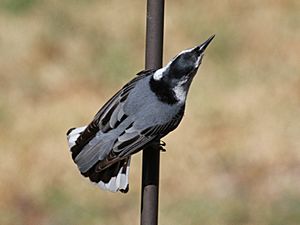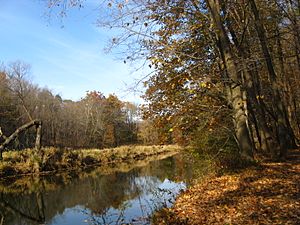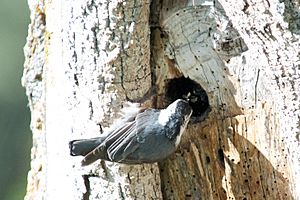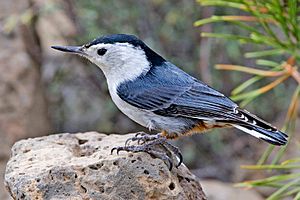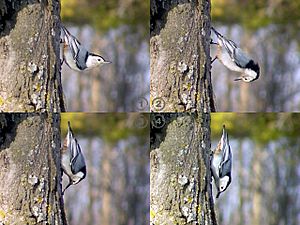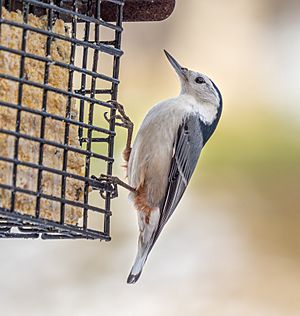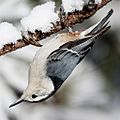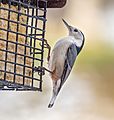White-breasted nuthatch facts for kids
Quick facts for kids White-breasted nuthatch |
|
|---|---|
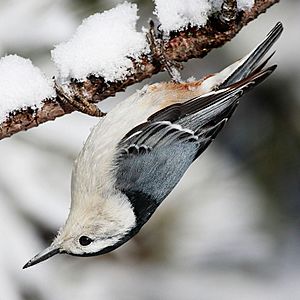 |
|
| Adult male S. c. carolinensis in Algonquin Provincial Park, Canada | |
| Conservation status | |
| Scientific classification | |
| Genus: |
Sitta
|
| Species: |
carolinensis
|
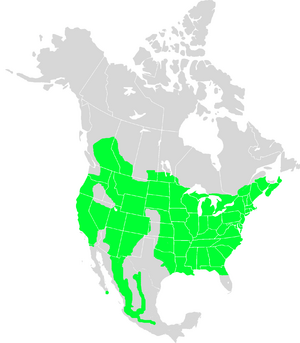 |
|
| Approximate year-round range | |
The white-breasted nuthatch (Sitta carolinensis) is a small songbird found across much of North America. It belongs to the nuthatch family. This bird is quite stocky, meaning it's a bit chunky. It has a large head, a short tail, a strong beak, and powerful feet.
You can spot it by its black cap, white face, chest, and sides. Its back is blue-gray, and its lower belly is a chestnut color. There are nine different types, or subspecies, of this nuthatch. They mostly look different because of their feather colors.
Like other nuthatches, the white-breasted nuthatch looks for insects on tree trunks and branches. It's special because it can move head-first down trees! In winter, it eats a lot of seeds, acorns, and hickory nuts. It stores these foods in the fall. These birds like to build their nests in old forests. They make their nests in holes in trees. Sometimes, they rub insects around the nest entrance. This might help keep squirrels away. Hawks, owls, and snakes are some of its predators. Even though forests are sometimes cut down, this bird is not in danger in most places.
Contents
What is a Nuthatch?
Nuthatches are small birds in a group called Sitta. Their English name comes from how some of them eat. They wedge big insects or seeds into cracks in trees. Then, they use their strong beaks to hack them open. The name Sitta comes from an old Greek word for nuthatch. Carolinensis means "from Carolina" in Latin. The white-breasted nuthatch was first described by an English bird expert, John Latham, in 1790.
Scientists study nuthatches to understand how different types are related. Sometimes, nuthatches that live far apart look very similar. For a while, the white-breasted nuthatch was thought to be the same as the white-cheeked nuthatch from the Himalayas. But studies have shown they are different.
What Does It Look Like?
The white-breasted nuthatch has a large head, a short tail, short wings, a strong beak, and powerful feet. It is about 13 to 14 centimeters (5 to 5.5 inches) long. Its wings can spread 20 to 27 centimeters (8 to 10.5 inches) wide. It weighs about 18 to 30 grams (0.6 to 1 ounce).
The adult male has pale blue-gray feathers on its back. It has a shiny black cap on its head and a black band on its upper back. Its wing feathers are very dark gray with lighter edges. When its wings are closed, they look pale gray and black with a thin white stripe. Its face and belly are white. The outer tail feathers are black with wide white stripes. You can easily see these stripes when the bird flies.
Female nuthatches usually have a thinner black band on their back. Their upper parts are a bit duller, and their undersides are more buff-colored than the males. Some females have gray caps, but many have black caps. This makes it hard to tell them apart from males just by looking. Young birds look like adults but are duller in color.
Like other nuthatches, this bird makes many different sounds. The male's mating song is a fast, nasal qui-qui-qui-qui-qui-qui-qui. When a pair of nuthatches talk to each other, especially in fall and winter, they make a thin, squeaky nit sound. They can say this up to 30 times a minute. A more noticeable sound is a sharp kri repeated quickly, like kri-kri-kri-kri-kri-kri-kri-kri.
There are three other smaller nuthatches that live in the same areas. But none of them have white feathers all around their eyes. The red-breasted nuthatch has a black line through its eye and reddish underparts. The brown-headed and pygmy nuthatches have brown caps and a white patch on the back of their necks.
Types of White-breasted Nuthatches
The white-breasted nuthatch has nine different subspecies. The differences between them are small and change slowly across their range. These subspecies are sometimes grouped into three main types. These groups are based on how they look, where they live, and their calls. The groups are from eastern North America, the Great Basin and central Mexico, and the Pacific coast.
The nuthatches in the western interior have the darkest upper parts. The eastern type has the palest back. The eastern type also has a thicker beak and a wider dark cap stripe. The calls of the three groups are different, as mentioned before.
| Subspecies | Where It Lives | How It Looks |
|---|---|---|
| S. c. carolinensis | Northeast North America, west to Saskatchewan and eastern Texas | Has the palest back and cap |
| S. c. nelsoni | Rocky Mountains, from northern Montana south to northwest Chihuahua | Has darker gray upper parts, a darker cap, and less contrast in its wings |
| S. c. tenuissima | From British Columbia through the Cascade Range to southern California | Smaller than S. c. nelsoni, with slightly paler upper parts and a more slender beak |
| S. c. aculeata | Western parts of Washington, Oregon and California, northernmost Baja California. | Smaller than S. c. tenuissima, with buff-colored underparts, slightly paler upper parts, and a more slender beak |
| S. c. alexandrae | Northern Baja California | Larger than S. c. aculeata, with slightly darker upper parts. Has the longest beak of all types |
| S. c. lagunae | Southernmost Baja California | Smaller than S. c. alexandrae with slightly darker underparts and more buff. Has a relatively stout beak |
| S. c. oberholseri | Southwest Texas and eastern Mexico | Very similar to S. c. nelsoni, but upper parts and underparts are slightly darker |
| S. c. mexicana | Western Mexico | Duller than S. c. oberholseri with grayer sides |
| S. c. kinneari | Southern Mexico in Guerrero and Oaxaca | Smallest subspecies, similar to S. c. mexicana but the female has more orange-buff underparts. Has a short, stout beak |
Where Do They Live?
The white-breasted nuthatch lives in woodlands across North America. This includes areas from southern Canada down to northern Florida and southern Mexico. In the eastern parts of its range, it likes old, open forests with deciduous (leaf-shedding) or mixed trees. This also includes orchards, parks, gardens in towns, and cemeteries. It mostly lives in low areas. In the west and Mexico, this nuthatch lives in open mountain pine-oak forests. It can nest as high as 3,200 meters (10,500 feet) in Nevada, California, and Mexico.
It's very important for them to have old or decaying trees with holes for nesting. Trees like oak, beech, and hickory are favorites in the east. This is because these trees also provide seeds for food. White-breasted nuthatches usually don't make their own nest holes. They use natural holes or old woodpecker nests.
This nuthatch, like most of its family, does not migrate. Adult birds usually stay in their territory all year. Sometimes, if there aren't enough seeds or if many young birds are born, they might move around more. This bird has been seen in unusual places like Vancouver Island and Bermuda. One even landed on a ship far out in the Atlantic Ocean in 1963!
Behavior and Life Cycle
Breeding and Nests
White-breasted nuthatches are monogamous, meaning they have one partner. Pairs form after the male performs a courtship dance. He bows to the female, spreads his tail, and droops his wings while swaying. He also gives her food. The pair sets up a territory in the woodland and stays together all year until one bird dies.
Their nest is usually in a natural hole in a decaying tree. Sometimes, it's an old woodpecker nest. The nest hole is often 3 to 12 meters (10 to 40 feet) high in a tree. They line the nest with fur, fine grass, and shredded bark. The female lays 5 to 9 eggs. The eggs are creamy-white with reddish-brown spots. They are about 19 by 14 millimeters (0.75 by 0.55 inches) in size.
The female bird sits on the eggs for 13 to 14 days until they hatch. The baby birds are born helpless and stay in the nest for another 18 to 26 days. Both parents feed the chicks in the nest. The male also feeds the female while she is sitting on the eggs. After leaving the nest, the young birds leave their parents' territory. They either find their own territory or become "floaters," which are single birds without a territory. These floaters are likely the ones that sometimes travel to new places.
This nuthatch sleeps in tree holes or behind loose bark when it's not breeding. It has a strange habit of taking its droppings out of the roosting spot in the morning. It usually sleeps alone. But in very cold weather, up to 29 birds have been seen sleeping together!
Staying Safe from Predators
Adult nuthatches can be hunted by owls and birds of prey like sharp-shinned and Cooper's hawks. Baby birds and eggs can be eaten by woodpeckers, small squirrels, and climbing snakes. When a predator is near the nest, the white-breasted nuthatch will flick its wings and make hn-hn calls.
When a bird leaves its nest hole, it wipes around the entrance with fur or plants. This makes it harder for predators to find the nest by smell. The nuthatch might also rub blister beetles around its nest entrance. The bad smell from the crushed insects might keep squirrels away. Squirrels are a big competitor for tree holes. The average lifespan of this nuthatch is two years. But the longest recorded life was twelve years and nine months!
Scientists have studied how nuthatches react to predators. They found that white-breasted nuthatches, which have shorter lives but more babies, worry more about predators that eat eggs. Red-breasted nuthatches, which live longer, worry more about predators that hunt adult birds. This shows how different birds protect their families based on their life strategies.
What Do They Eat?
The white-breasted nuthatch looks for food on tree trunks and branches. It moves like woodpeckers and treecreepers. But it doesn't use its tail for support. Instead, it moves in quick hops using its strong legs and feet. All nuthatches are special because they can go down tree trunks head-first. They can also hang upside-down under branches.
This nuthatch eats both insects and seeds. It's an omnivore. It puts large food items like acorns or hickory nuts into cracks in tree trunks. Then, it hammers them open with its strong beak. It stores extra seeds under loose bark or in tree cracks. In winter, almost 70% of its diet can be seeds. But in summer, it mainly eats insects. The insects it eats include caterpillars, ants, and pests like pine weevils and scale insects. This bird sometimes feeds on the ground. It also likes to visit bird feeders for nuts, suet, and sunflower seeds. It often takes these seeds away to store them.
White-breasted nuthatches often join small mixed groups of birds in winter. These groups are usually led by titmice and chickadees. Nuthatches and downy woodpeckers often join them. Birds in these groups help each other find food and avoid predators.
Status and Protection
The white-breasted nuthatch is a common bird. It lives in a very large area, estimated to be about 8.6 million square kilometers (3.3 million square miles). There are about 10 million of these birds in total. Their population seems to be growing. Because of this, they are not considered in danger. The IUCN Red List lists them as a Least Concern species.
Removing dead trees from forests can cause problems for this bird in some places. This is because they need holes in trees for nesting. Their numbers have gone down in Washington, Florida, and parts of the southeastern U.S. But in other areas, like Alberta, their breeding range is growing. Their numbers are also increasing in the northeast because forests are regrowing. This nuthatch is protected by the Migratory Bird Treaty Act of 1918. Canada, Mexico, and the United States, where the bird lives, have all signed this agreement.
Images for kids
-
Adult male S. c. carolinensis in Algonquin Provincial Park, Canada
See also
 In Spanish: Trepador pechiblanco para niños
In Spanish: Trepador pechiblanco para niños



